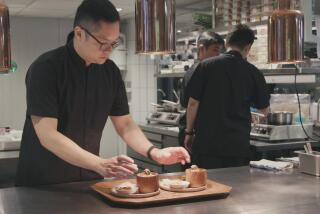Three-Wheeling Among High-Rises of Singapore
To the uninitiated, a first look at Singapore might lead one to believe that it is nothing but a clean concrete machine, distinctly lacking in character, up-tight and obsessed with rules.
To be sure, Singapore is one of the cleanest places I have ever visited (the fine for littering ranges from stiff to intolerable). It is also notorious for being the only venue in a David Bowie worldwide tour where the concert promoter lost money due to a lack of ticket sales. The people wanted to go, I was told, but they weren’t sure if they should.
The argument is made that Singapore is a major Asian financial center with a host of duty-free goods and little more. It’s true that the old Singapore is fast disappearing, replaced by high-rise buildings and a growing worry among some of its citizens that something historic will not take precedence over something that serves the needs of the business community.
But if there is any romance left in Singapore, it can still be found at the city’s Waterloo Park or in front of the legendary Raffles Hotel. That’s where you can find them, some out of habit, others acting on tradition, waiting patiently for their fares.
They are the last remaining trishaw drivers of Singapore. The trishaws are three-wheeled bicycle/cart hybrids.
Fixture of History
The government considers them more a social embarrassment than a living fixture of Oriental history. But the trishaw survives, barely, in remnants of a once large fleet of trishaws that were an integral form of Singapore transportation.
The trishaw’s forerunner was the rickshaw. The first rickshaws were shipped over from Shanghai to Singapore in 1880.
Many of today’s trishaw pedalers began working rickshaws in the late 1930s. When the Japanese occupied Singapore they introduced the trishaws to the country.
After World War II trishaws soared in popularity. By 1947 more than 10,000 trishaws were being pedaled around Singapore, and a good driver could earn $50 a day.
Most of the drivers were Chinese immigrants who pedaled their trishaws as taxis or were hired by wealthy families and businesses.
Today, most of the trishaws are snug, Spartan affairs, but some have been equipped with radios, tape players, cushy seats and flashing lights.
The “boys” who drive them are anything but--their average age is 60, and they pedal around Singapore with remarkable energy and speed.
No Exception
My driver was no exception. Lim Guan Seng looks and acts much younger than his 68 years. He has eight children and 11 grandchildren. “I am very happy in my work,” he says. But based on size and weight, I felt I should be driving him.
He hops onto the trishaw’s green striped seat, and we head off into the frenetic Singapore traffic, the bright orange metal trishaw frame reflecting dozens of automobile headlights.
Lim reaches over the handlebars and switches on his cassette tape player. Immediately our presence on the streets is announced by the music of Michael Jackson and Ashford and Simpson.
Lim has been a trishaw driver for nearly 40 years. He moved to Singapore from Indonesia at the end of the war in 1945. “I felt I would have a good future here for me and my family,” he says. “And I think I have made a good decision.”
Lim pedals hard and fast, and our speed picks up as he heads down Upper Dickson Street, then to Dunlop Street and onto Serangom Road.
It is a route Lim often travels at night, weaving in and out of traffic, cutting the distance between us and some of Singapore’s 10,000 fast taxis exceedingly close.
“The people all know me,” he says, “and this city still holds for me some mystery and surprise.”
Lim stopped the trishaw in front of the legendary Bugis Street, a mandatory stop for the trishaw drivers.
There was a time when a benign anarchy reigned on Bugis Street, where the only rule was that there were no rules. It was a place where you could get anything you wanted, anytime you wanted it, where the prices were below cheap and no one asked the wrong questions.
Now, about the only thing one can get on Bugis Street are the stories of the way it used to be. Some vendors remain, selling bootleg audio cassettes of top U.S. rock hits for 50 cents or $1.
Then it was back to Orchard Road and a stop at Raffles. “You must go in,” he motions. “I wait.”
He’s right. The most legendary of the Singapore landmarks is the venerable Raffles. One cannot go to Singapore without a visit, a stay or a meal at the place. But one look at the hotel indicates that it has been a long time indeed since Somerset Maugham wrote that Raffles “stands for all the fables of the exotic East.”
Fading Hotel
Today, the fading hotel is a first stop for first-time tourists who can’t leave Singapore without a drink at the Long Bar, where the barman claims to be a direct descendant of the alchemist who concocted the original Singapore Sling back in 1915.
Once considered Asia’s finest hotel, it has certainly been eclipsed by the likes of the Oriental in Bangkok, the Manila Hotel in Manila and the Regent and Peninsula hotels in Hong Kong.
Still, the hotel’s rooms offer what the other sleeping palaces often cannot: a glimpse of Singapore’s colonial days and memories of gin-sipping at Cad’s Alley, Noel Coward dancing naked down an open corridor, and yes, Somerset Maugham.
Raffles has named some of its rooms after famous writers (Maugham, Kipling et al.), and they are spacious and reasonably priced. But with any luck, Raffles will not meet the unfortunate, and unnecessary, fate of places such as Hong Kong’s Repulse Bay hotel. After about 10 years of maneuvering, the government of Singapore and Raffles’ owners, a major Singapore bank and some private developers, are poised to spend up to $375 million to restore Raffles.
Plans call for construction of a 500-room tower complex at the rear of the building and a total refurbishing of the existing structure.
An hour later, when I left the hotel, Lim was still there, waiting for me. “See?” he said. “Very old, very nice, yes?” he asked as I got back into the trishaw. When we arrived eight minutes later back at my hotel, I paid Lim $10, the going rate, and thanked him.
“No,” he said. “Thank you.” Then he smiled, saluted me, and was off into the night.
More to Read
Sign up for The Wild
We’ll help you find the best places to hike, bike and run, as well as the perfect silent spots for meditation and yoga.
You may occasionally receive promotional content from the Los Angeles Times.






